Abstract
ADAMTS13 cleaves ultralarge and hyperreactive von Willebrand factor (ULVWF) freshly released from activated endothelial cells to smaller and less active forms. This process may be affected by the amount of ULVWF released and the processing capacity of ADAMTS13, contributing to the development of thrombotic diseases. We examined the effects of inflammatory cytokines on the release and cleavage of ULVWF to evaluate potential links between inflammation and thrombosis. Human umbilical vein endothelial cells were treated with interleukin 6 (IL-6), IL-8, or tumor necrosis factor α (TNF-α), and the formation of platelet-decorated ULVWF strings was quantitated. IL-8 and TNF-α significantly stimulated the release of ULVWF in a dose-dependent manner. IL-6 induced ULVWF release only when it was in complex with the soluble IL-6 receptor. IL-6, but not IL-8 nor TNF-α, inhibited the cleavage of ULVWF strings by ADAMTS13 under flowing, but not static, conditions. These results suggest that inflammatory cytokines may stimulate the ULVWF release (IL-8 and TNF-α) and inhibit the ULVWF cleavage (IL-6), resulting in the accumulation of hyperreactive ULVWF in plasma and on the surface of endothelial cells to induce platelet aggregation and adhesion on the vascular endothelium. The findings describe a potential linkage between inflammation and thrombosis that may be of therapeutic importance.
Introduction
The von Willebrand factor (VWF) multimers mediate platelet adhesion to subendothelium exposed at the site of vessel injury. VWF is synthesized and stored in α granules of megakaryocytes/platelets and the Weibel-Palade bodies of endothelial cells.1-3 Endothelial cells, the major source of plasma VWF, release VWF multimers both constitutively and on stimulation.3,4 VWF forms released through stimulation are rich in the ultralarge (UL) multimers that are hyperreactive,4,5 capable of forming high-strength bonds with the platelet glycoprotein (GP) Ib-IX-V complex in the absence of any modulators.6-8 These hyperreactive ULVWF multimers are normally cleaved by a VWF-cleaving enzyme in plasma into smaller and less active form before their release into plasma. The cleavage occurs in vitro at a single peptide bond between Y842 and M843 in the VWF-A2 domain, generating 176-kDa and 140-kDa fragments that are found in the normal circulation.9,10 The VWF-cleaving enzyme has recently been characterized and found to be a member of the ADAMTS (a disintegrin and metalloprotease with thrombospondin motif) metalloprotease family (ADAMTS13).11,12 Despite recent progress in characterizing conditions in which ADAMTS13 acts optimally, how this metalloprotease cleaves ULVWF in vivo remains largely unknown.
We have recently demonstrated that ULVWF multimers secreted from endothelial cells are anchored to the cell surface as extraordinarily long stringlike structures capable of inducing platelet adhesion and aggregation.13 These ULVWF multimeric strings are rapidly cleaved by ADAMTS13 in vitro at a kinetic that is more than 1000-fold faster than that observed under static conditions, suggesting that ULVWF processing may occur on or near the surface of the vascular endothelial cells in vivo.
The process of ULVWF proteolysis is in a constant balance between the amount of ULVWF released from endothelial cells and the processing capacity of ADAMTS13. Factors that disrupt this balance result in pathologic conditions ranging from bleeding to thrombosis. For example, a sustained deficiency of this metalloprotease, either congenital or acquired, results in a systemic thrombotic microangiopathy called thrombotic thrombocytopenic purpura (TTP).14 Increased proteolysis is associated with bleeding disorders such as the type 2A von Willebrand disease.15 In addition to these permanent defects, the ULVWF/ADAMTS13 control mechanism may also be influenced either by rapid and excessive ULVWF release or a transient inhibition of ULVWF cleavage by ADAMTS13. Increased plasma levels of VWF have been reported in a wide variety of disease states, such as bacterial or viral infections,16,17 trauma,18 autoimmune diseases,19,20 and coronary and peripheral artery diseases.21,22 Although these diseases cannot be linked by a common cause, they are, by the common pathology of inflammation, suggesting that inflammation may be the shared stimulus for release of endothelial cell-derived ULVWF. The large amount of newly released ULVWF may lead to a consumptive deficiency of ADAMTS13. Reiter et al23 showed that administration of 1-deamino-8-D-arginine vasopressin (DDAVP), which stimulates VWF release from endothelial cells,24 resulted in transient appearance of ULVWF in plasma and decrease in ADAMTS13 activity, indicating that overwhelming release of ULVWF may, at least transiently, exhaust ADAMTS13 activity. The question is whether inflammatory mediators such as cytokines and chemokines, which are often strong agonists to endothelial cells, may have similar effects. This determination may provide a critical link between inflammation and thrombosis.
We have examined 3 inflammatory cytokines, interleukin 6 (IL-6), IL-8, and tumor necrosis factor α (TNF-α), for their effects on the release and cleavage of ULVWF. These cytokines are chosen because they are released from endothelial cells and leukocytes during the early stage of systemic inflammation.25-27 Although their effects on the release of ULVWF from vascular endothelial cells remain to be investigated, they have profound stimulatory effects on endothelial cells.27,28
Materials and methods
Platelet and plasma preparations
Human blood was obtained from 32 healthy donors under a protocol approved by the Institutional Review Board of the Baylor College of Medicine. These donors had no history of thrombosis and had not been on medications for at least 2 weeks. All donors signed consent forms. There were 18 women and 14 men in the donor pool, ranging from 21 to 56 years of age.
To obtain washed platelets, blood was drawn into acid-citrate-dextrose anticoagulant (ACD; 85 mM sodium citrate, 111 mM glucose, and 71 mM citric acid, 10% vol/vol) and centrifuged at 150g for 15 minutes at 24° C to separate platelet-rich plasma (PRP). PRP was then centrifuged at 900g for 10 minutes to obtain platelets. The platelet pellets were washed once with a CGS buffer (13 mM sodium citrate, 30 mM glucose, and 120 mM sodium chloride, pH 7.0) and resuspended in Ca++-, Mg++-free Tyrode buffer (138 mM sodium chloride, 5.5 mM glucose, 12 mM sodium bicarbonate, 2.9 mM potassium chloride, and 0.36 mM sodium phosphate dibasic, pH 7.4).
For most of the studies, platelet-poor plasma (PPP) was used as the source of ADAMTS13 metalloprotease. For this, blood was drawn into 0.38% sodium citrate, instead of ACD, and was first centrifuged at 150g for 15 minutes at 24° C to obtain PRP and then at 900g for 10 minutes to obtain PPP.
Endothelial culture
Under a protocol approved by the Institutional Review Board of the Baylor College of Medicine, endothelial cells were obtained from human umbilical veins (HUVECs) as described previously.13,29 Briefly, the umbilical cords were first washed with phosphate buffer (140 mM NaCl, 0.4 mM KCl, 1.3 mM NaH2PO4, 1.0 mM Na2HPO4, 0.2% glucose, pH 7.4), and then infused with a collagenase solution (0.02%; Invitrogen Life Technologies, Carlsbad, CA). After 30 minutes of incubation at room temperature, the cords were rinsed with 100 mL of the phosphate buffer. Endothelial cells were collected by centrifugation and plated on a culture dish in Medium 199 (Invitrogen Life Technologies) containing 20% heat-inactivated fetal calf serum and 0.2 mM L-glutamine.
To induce the release of ULVWF multimers, HUVECs were stimulated with 25 μM histamine (Sigma Aldrich, St Louis, MO). Effects of cytokines on the release of ULVWF were determined by incubating HUVECs with 1 of the 3 cytokines for up to 24 hours before the perfusion experiments. Cytokines tested in the studies were IL-6 (recombinant human IL-6; R&D Systems, Minneapolis, MN), IL-8 (recombinant human IL-8; R&D Systems), and TNF-α (recombinant human TNF-α; R&D Systems). The reagents were reconstituted in phosphate-buffered saline (PBS), aliquoted, and stored at –20° C until use.
The formation and cleavage of VWF strings was studied under flow in a parallel-plate flow chamber system and observed by phase-contrast video microscopy as previously described.13
Parallel-plate flow chamber system and experiments under flow
The formation and cleavage of VWF strings was studied under flow in a parallel-plate flow chamber system and observed by phase-contrast video microscopy.13 The endothelial cells are grown until confluent on the gelatin-coated glass coverslips, which were then assembled to form the bottom of the flow chamber. The assembled parallel-plate flow chamber was mounted onto an inverted-stage microscope (Eclipse TE300; Nikon, Garden City, NY) equipped with a high-speed digital camera (Model Quantix; Photometrics, Tucson, AZ). The chamber was kept at 37° C with a thermostatic air bath during the experiments. To induce the formation of ULVWF strings, a syringe pump connected to the outlet port drew the platelet suspension over the histamine-stimulated HUVECs at defined flow rates to generate a wall shear stress of 2.5 dyn/cm2. Images were acquired with a ×40 superflow objective (Nikon), and acquired images were analyzed offline using MetaMorph software (Universal Images, West Chester, PA). The strings were quantitated by counting numbers of strings in 20 continuous view-fields of ×400 magnification.
ELISA
The formation of IL-6 and soluble IL-6 receptor (sIL-6R; Sigma Aldrich) in vitro was determined by an enzyme-linked immunosorbent assay (ELISA) method. IL-6 (100 ng/mL of coating concentration) was first incubated in wells of a microtiter plate at room temperature for 2 hours. The wells were then washed with PBS 3 times and incubated with sIL-6R (80 ng/mL) for an additional 30 minutes. After washing to remove the unbound molecules, wells were incubated with 3% bovine serum albumin (BSA) to block nonspecific binding. Bound sIL-6R was detected by incubating wells with a mouse monoclonal anti–IL-6R antibody (BD Biosciences, San Jose, CA) for 60 minutes, followed by additional 30 minutes of incubation with horseradish peroxidase (HRP)–conjugated rabbit antimouse IgG. Positive color was developed with o-phenylenediamine and detected in a spectrophotometer (Bio-Rad Laboratories, Hercules, CA) at 490 nm.
Purification of ADAMTS13
ADAMTS13 was partially purified on a diethylaminoethanol (DEAE) column from factor VIII/VWF concentrate using the method described earlier.30 The total protein content of the ADAMTS13 preparation was 126 μg/mL. Purified ADAMTS13 cleaved VWF after a 24-hour incubation at 37° C in the presence of 1 M urea and BaCl2, yielding 176-kDa and 140-kDa fragments on reduced sodium dodecyl sulfate–polyacrylamide gel electrophoresis (SDS-PAGE) gels.
Cleavage of ULVWF under static conditions
The ADAMTS13 activity was measured under static conditions using ULVWF as substrate.31 This method is modified from that of Furlan et al.9 Briefly, normal plasma as the source of ADAMTS13 was diluted (1:5) with a low ion strength Tris (tris(hydroxymethyl)aminomethane)–saline buffer and activated by 5 minutes of incubation with 1 mM BaCl2. The pretreated plasma was then mixed with ULVWF. The mixture was dialyzed in 1.5 M urea for 24 hours at 37° C, and then separated on 1% agarose gel at 50 V constant voltage until proteins had traveled 1 cm. The separated proteins were transferred to a polyvinylidene difluoride (PVDF) membrane and VWF multimers detected by Western blot using a polyclonal anti-VWF antibody (Dako, Carpinteria, CA).
Statistical analysis
All the experimental data were presented as mean ± SE. The unpaired 2-tailed Student t test was used for all data analysis and P values less than .05 were considered statistically significant.
Results
IL-8 and TNF-α, but not IL-6, stimulated HUVECs to release ULVWF under flow
We tested the effects of cytokines on the release of ULVWF from endothelial cells by measuring the formation of ULVWF-platelet strings under flow. When HUVECs stimulated with IL-8, TNF-α, or histamine (as positive control) were perfused with washed platelets, ULVWF-platelet strings were detected 30 seconds after perfusion (Figure 1). The numbers of ULVWF strings formed in the presence of IL-8 or TNF-α increased with increasing doses of the cytokines, with maximal effects observed at 100 ng/mL and 10 ng/mL for IL-8 and TNF-α, respectively (Figure 2A). At the maximal concentration, the numbers of ULVWF strings formed on endothelial cells stimulated with TNF-α reached a plateau after 60 minutes of incubation (Figure 2B). In contrast to IL-8 and TNF-α, IL-6 (10-100 ng/mL) induced the secretion of fewer ULVWF strings (Figures 1 and 2).
IL-8 and TNF-α, but not IL-6, stimulated the release of ULVWF multimers. HUVECs were stimulated with TNF-α (50 ng/mL), IL-6 (100 ng/mL), or IL-8 (100 ng/mL) for 30 minutes and then perfused with washed platelets suspended in Tyrode buffer at 2.5 dyne/cm2. The formation of the platelet-decorated ULVWF strings was detected on endothelial cells stimulated with TNF-α (A) or IL-8 (B), but not on those stimulated with IL-6 (C). Histamine-stimulated endothelial cells (D) were used as positive control. No strings formed on untreated endothelial cells (E). The figure is a representative of 6 separate experiments (bar = 100 μm).
IL-8 and TNF-α, but not IL-6, stimulated the release of ULVWF multimers. HUVECs were stimulated with TNF-α (50 ng/mL), IL-6 (100 ng/mL), or IL-8 (100 ng/mL) for 30 minutes and then perfused with washed platelets suspended in Tyrode buffer at 2.5 dyne/cm2. The formation of the platelet-decorated ULVWF strings was detected on endothelial cells stimulated with TNF-α (A) or IL-8 (B), but not on those stimulated with IL-6 (C). Histamine-stimulated endothelial cells (D) were used as positive control. No strings formed on untreated endothelial cells (E). The figure is a representative of 6 separate experiments (bar = 100 μm).
IL-8 and TNF-α induced the release of ULVWF from HUVECs. (A) HUVECs were treated with various concentrations of cytokines for 30 minutes and then perfused with washed platelets suspended in Tyrode buffer at 2.5 dyne/cm2. The ULVWF released from HUVECs stimulated by IL-8 or TNF-α had maximal effects at 100 and 10 ng/mL, respectively (mean ± SEM, Student t test, n = 9). (B) HUVECs were treated with 50 ng/mL TNF-α for up to 24 hours before perfusion with washed platelets. The formation of ULVWF strings increased with incubation times, reaching a plateau after 60 minutes (mean ± SEM, n = 4).
IL-8 and TNF-α induced the release of ULVWF from HUVECs. (A) HUVECs were treated with various concentrations of cytokines for 30 minutes and then perfused with washed platelets suspended in Tyrode buffer at 2.5 dyne/cm2. The ULVWF released from HUVECs stimulated by IL-8 or TNF-α had maximal effects at 100 and 10 ng/mL, respectively (mean ± SEM, Student t test, n = 9). (B) HUVECs were treated with 50 ng/mL TNF-α for up to 24 hours before perfusion with washed platelets. The formation of ULVWF strings increased with incubation times, reaching a plateau after 60 minutes (mean ± SEM, n = 4).
Although normal plasma concentrations of these cytokines are very low, they increase up to several hundred to thousand folds during myocardial infarction32,33 and other conditions with acute inflammation.34 For example, Ueda et al reported that plasma IL-6 levels increased to 27 ng/mL from less than 10 pg/mL.35 The concentrations tested in this study represented the likely plasma levels of these cytokines during severe inflammation.
IL-6 in complex with sIL-6R stimulated the formation of ULVWF strings under flow
The absence of the IL-6R on HUVECs may be one reason for the failure of IL-6 to induce HUVECs to release ULVWF. To address this possibility, we tested the ability of IL-6 that complexed with sIL-6R, which has previously been shown to act on cells that lack IL-6R,36,37 to stimulate HUVECs. The binding of IL-6 to sIL-6R was first demonstrated by an ELISA, showing that sIL-6R specifically bound to IL-6, but not to BSA (Figure 3A). We prepared the preformed IL-6–sIL-6R complex by incubating IL-6 with sIL-6R for 30 minutes at room temperature. The complex was used to stimulate HUVECs for 10 to 60 minutes. Under these conditions, ULVWF strings were detected on the IL-6–sIL-6R–stimulated HUVECs (Figure 3B), but the numbers of strings formed (12.6 ± 4.4) were fewer than that by histamine (66.0 ± 29.7), IL-8 (47.1 ± 11.5), or TNF-α (59.6 ± 14.9, Student t test, n = 12, P < .001; Figure 3B). sIL-6R alone had no stimulatory effects on the release of ULVWF from HUVECs.
IL-6 bound sIL-6R and stimulated ULVWF release from HUVECs. Recombinant human IL-6 (100 ng/mL) was incubated with sIL-6R (80 ng/mL), and IL-6 binding to sIL-6R detected using a monoclonal IL-6 antibody. (A). sIL-6R bound to immobilized IL-6, but not BSA (mean ± SEM, Student t test, n = 3, *P < .001, as compared to plates coated with BSA). (B). HUVECs were treated with preformed IL-6–sIL-6R complexes for 30 minutes and perfused with washed platelets at 2.5 dyne/cm2 shear stress. The platelet-decorated ULVWF strings formed on the complex-stimulated HUVECs, but the number of strings was significantly less than those of cells stimulated with histamine, IL-8, and TNF-α (mean ± SEM, Student t test, n = 3, **P < .01, compared to stimulation with histamine).
IL-6 bound sIL-6R and stimulated ULVWF release from HUVECs. Recombinant human IL-6 (100 ng/mL) was incubated with sIL-6R (80 ng/mL), and IL-6 binding to sIL-6R detected using a monoclonal IL-6 antibody. (A). sIL-6R bound to immobilized IL-6, but not BSA (mean ± SEM, Student t test, n = 3, *P < .001, as compared to plates coated with BSA). (B). HUVECs were treated with preformed IL-6–sIL-6R complexes for 30 minutes and perfused with washed platelets at 2.5 dyne/cm2 shear stress. The platelet-decorated ULVWF strings formed on the complex-stimulated HUVECs, but the number of strings was significantly less than those of cells stimulated with histamine, IL-8, and TNF-α (mean ± SEM, Student t test, n = 3, **P < .01, compared to stimulation with histamine).
IL-6, but not IL-8 and TNF-α, inhibited the cleavage of ULVWF-platelet strings on endothelial cells under flow
In addition to their effects on the release of ULVWF from endothelial cells, we also determined whether these cytokines affected the ADAMTS13-mediated cleavage of ULVWF-platelet strings formed on the stimulated endothelial cells. We have previously demonstrated that ULVWF-platelet strings are immediately cleaved and consequently not detectable if normal PRP, which contains ADAMTS13, is perfused over stimulated HUVECs.13 To determine the effects on ADAMTS13 activity, we pretreated normal PRP with various concentrations of cytokines for 10 to 30 minutes before perfusion. Under these conditions, we could not detect the formation of ULVWF-platelet strings with PRP pretreated with either IL-8 or TNF-α (Figure 4). In contrast, ULVWF strings were not efficiently cleaved if PRP was pretreated with IL-6 (Figure 4). The inhibitory effect of IL-6 was nonlinearly related with the amount of IL-6 used, with a maximal effect observed at 100 ng/mL. The inhibitory effect of IL-6 (100 ng/mL) was also observed if whole blood was treated with IL-6 (Figure 5A) and if IL-6 was in complex with sIL-6R (Figure 5A).
IL-6, but not IL-8 and TNF-α, inhibited cleavage of ULVWF strings by ADAMTS13 under flow. Normal PRP samples were pretreated with each of the 3 cytokines and perfused over histamine-stimulated HUVECs at 2.5 dyne/cm2 shear stress. The platelet-decorated ULVWF strings were mostly cleaved in the presence of PRP treated with IL-8 or TNF-α, but not in the presence of IL-6–pretreated PRP. The maximal inhibitory effect on ULVWF cleavage was observed at 100 ng/mL IL-6. As controls, there was no string formed with untreated PRP (100% cleavage), whereas the perfusion of washed platelets suspended in Tyrode buffer resulted in a significant number of strings (no cleavage). Figures were mean ± SEM, Student t test, n = 6, *P < .01 compared to IL-8– and TNF-α–treated PRP.
IL-6, but not IL-8 and TNF-α, inhibited cleavage of ULVWF strings by ADAMTS13 under flow. Normal PRP samples were pretreated with each of the 3 cytokines and perfused over histamine-stimulated HUVECs at 2.5 dyne/cm2 shear stress. The platelet-decorated ULVWF strings were mostly cleaved in the presence of PRP treated with IL-8 or TNF-α, but not in the presence of IL-6–pretreated PRP. The maximal inhibitory effect on ULVWF cleavage was observed at 100 ng/mL IL-6. As controls, there was no string formed with untreated PRP (100% cleavage), whereas the perfusion of washed platelets suspended in Tyrode buffer resulted in a significant number of strings (no cleavage). Figures were mean ± SEM, Student t test, n = 6, *P < .01 compared to IL-8– and TNF-α–treated PRP.
IL-6 inhibited the cleavage of ULVWF strings under different conditions. (A) PRP treated with preformed IL-6–sIL-6R complexes inhibited the cleavage of ULVWF strings similarly to that of IL-6 alone. IL-6 also inhibited cleavage of ULVWF strings in whole blood. (B) Pretreatment of partially purified ADAMTS13 with IL-6 inhibited the cleavage of ULVWF strings under flow by approximately 50%. Figures are mean ± SEM, Student t test, n = 6, *P < .01 compared to untreated PRP or purified ADAMTS13.
IL-6 inhibited the cleavage of ULVWF strings under different conditions. (A) PRP treated with preformed IL-6–sIL-6R complexes inhibited the cleavage of ULVWF strings similarly to that of IL-6 alone. IL-6 also inhibited cleavage of ULVWF strings in whole blood. (B) Pretreatment of partially purified ADAMTS13 with IL-6 inhibited the cleavage of ULVWF strings under flow by approximately 50%. Figures are mean ± SEM, Student t test, n = 6, *P < .01 compared to untreated PRP or purified ADAMTS13.
To determine whether the inhibitory effect of IL-6 was directly on ADAMTS13 or indirectly through other molecules in plasma, we tested the effect of IL-6 on partially purified ADAMTS13. For this, washed platelets were mixed with ADAMTS13 (1:1 vol/vol), and then perfused over histamine-stimulated HUVECs under 2.5 dyne/cm2 shear stress. In the absence of IL-6, the partially purified ADAMTS13 cleaved 100% of the ULVWF strings within 2 minutes after perfusion was initiated, whereas IL-6 pretreatment of ADAMTS13 resulted in approximately 50% inhibition of ADAMTS13 activity (Figure 5B).
Kinetics of IL-6 inhibition on the cleavage of ULVWF-platelet strings under flow
To further determine the kinetics of IL-6 inhibition, we first perfused washed platelets suspended in Tyrode buffer over histamine-stimulated HUVECs to allow ULVWF-platelet strings to form and then a solution containing purified ADAMTS13 with or without preincubation with IL-6 (100 ng/mL). As shown in Figure 6, the purified ADAMTS13 cleaved the ULVWF-platelet strings within 2 minutes of perfusion, whereas plasma from patients with congenital thrombotic thrombocytopenic purpura failed to do so even after prolonged 15 minutes of perfusion. ADAMTS13 pretreated with IL-6 cleaved ULVWF strings more slowly than untreated ADAMTS13 with more than 80% of ULVWF-platelet strings remaining after 2 minutes of perfusion (Figure 6). It took 15 minutes for IL-6–treated ADAMTS13 to cleave ULVWF strings to the extent as untreated metalloprotease.
Time course of IL-6 inhibition on the cleavage of ULVWF strings. The rates of cleavage of ULVWF strings by normal plasma, plasma pretreated with 100 ng/mL IL-6, or plasma from patients with congenital TTP were measured by quantitating the numbers of ULVWF-platelet strings formed on HUVECs over a period of 15 minutes. Normal plasma completely cleaved and released ULVWF strings from endothelial cells within 2 minutes after the initiation of perfusion. Cleavage by plasma treated with IL-6 was significantly delayed with maximal cleavage achieved 15 minutes after perfusion initiation. TTP plasma failed to cleave ULVWF strings within 15 minutes of perfusion. Figures are mean ± SEM, n = 4.
Time course of IL-6 inhibition on the cleavage of ULVWF strings. The rates of cleavage of ULVWF strings by normal plasma, plasma pretreated with 100 ng/mL IL-6, or plasma from patients with congenital TTP were measured by quantitating the numbers of ULVWF-platelet strings formed on HUVECs over a period of 15 minutes. Normal plasma completely cleaved and released ULVWF strings from endothelial cells within 2 minutes after the initiation of perfusion. Cleavage by plasma treated with IL-6 was significantly delayed with maximal cleavage achieved 15 minutes after perfusion initiation. TTP plasma failed to cleave ULVWF strings within 15 minutes of perfusion. Figures are mean ± SEM, n = 4.
Cytokines had no inhibitory effects on the cleavage of ULVWF under static conditions
Having demonstrated an inhibitory effect of IL-6 on the cleavage of ULVWF strings on endothelial cells under a flow condition, we next tested the effects of this inflammatory cytokine on the cleavage of ULVWF under a static condition. Normal plasma was incubated with each of 3 cytokines for 30 minutes at room temperature and the ADAMTS13 activity then measured in the presence of barium and urea. As shown in Figure 7, the cleavage by normal plasma under static conditions was not altered by pretreating plasma with IL-6, IL-8, or TNF-α for 30 minutes at room temperature.
IL-6, IL-8, and TNF-α did not inhibit cleavage of ULVWF multimers under static conditions. ULVWF multimers were incubated with normal plasma or plasma pretreated for 30 minutes at room temperature with IL-6, IL-8, or TNF-α in the presence of urea and barium. After a 24-hour incubation, plasma treated with each cytokine cleaved ULVWF substrate to the same extent as untreated plasma. The figure is a representative of 3 independent experiments.
IL-6, IL-8, and TNF-α did not inhibit cleavage of ULVWF multimers under static conditions. ULVWF multimers were incubated with normal plasma or plasma pretreated for 30 minutes at room temperature with IL-6, IL-8, or TNF-α in the presence of urea and barium. After a 24-hour incubation, plasma treated with each cytokine cleaved ULVWF substrate to the same extent as untreated plasma. The figure is a representative of 3 independent experiments.
Discussion
We have demonstrated that inflammatory cytokines have distinct effects on the release of ULVWF from HUVECs and the activity of the VWF-cleaving metalloprotease, ADAMTS13. IL-8, TNF-α, and, to a lesser extent, the IL-6–sIL-6R complex stimulate the release of ULVWF from endothelial cells in a dose-dependent manner (Figures 1 and 2). IL-6, but not IL-8 or TNF-α, inhibits the cleavage of ULVWF strings by ADAMTS13 under flowing, but not static, conditions (Figures 3 and 7). These results suggest that inflammatory cytokines released during a variety of pathologic conditions may affect the balance between the quantity of ULVWF multimers released from endothelial cells and the rate of ULVWF cleavage by ADAMTS13. As a result, ULVWF multimers may persist on vascular endothelial cells and in plasma long enough to induce platelet adhesion and aggregation, potentially leading to thrombosis. These findings may provide a linkage between inflammation and thrombosis.
Two cytokines that include significant release of ULVWF are known agonists for endothelial cells. IL-8, the prototype member of the CXC subfamily of chemokines, is released from many different cell types in response to a variety of inflammatory stimuli.38,39 In endothelial cells, IL-8 is stored in Weibel-Palade bodies along with ULVWF multimers and P-selectin.39,40 Upon release, it activates endothelial cells, especially in microvascular endothelium28,41 and mediates the formation of plateletleukocyte aggregates.42 TNF-α, predominantly derived from monocytes,28 activates endothelial cells to release IL-8, IL-6, and other cytokines.28,43,44
IL-6 has been previously demonstrated to exert procoagulant effects on platelets,45,46 stimulate platelet production,47,48 enhance platelet response to thrombin,46 stimulate the hepatic release of C-reactive protein49 and fibrinogen,28 and promote the proliferation of vascular smooth muscle cells.28 We found that IL-6 alone does not stimulate the ULVWF release from HUVECs, probably because these cells lack IL-6R.50,51 However, the IL-6–sIL-6R complex induces a small but significant amount of ULVWF release from HUVECs (Figure 3). Our data are consistent with previous reports that the IL-6–sIL-6R complex stimulates endothelial cells to express E-selectin, intracellular adhesion molecule-1, and vascular cellular adhesion molecule-1.51,52 The finding is also consistent with the reported mechanism that IL-6 acts on non-IL-6R–expressing cells by forming a complex with its soluble receptor.53,54 The sIL-6R can be produced during inflammation by membrane shedding from leukocytes into plasma.55,56 The IL-6–sIL-6R complex binds to gp130, the cytokine common signal transducer of the IL-6 cytokine family that is expressed in most cell types.57,58 On binding, gp130 dimerizes and undergoes tyrosine phosphorylation, resulting in subsequent activation of the transcription factor STAT3.59,60
Compared to the effect on endothelial cells, IL-6 significantly inhibits the rate of the cleavage of ULVWF-platelet strings by ADAMTS13 (Figures 5 and 6). How IL-6 inhibits ADAMTS13 activity remains to be further investigated. One of the potential mechanisms for the inhibitory effect of IL-6 on ADAMTS13 is that IL-6 may impair docking of ADAMTS13 to the ULVWF strings under flow,61 because this effect is only observed for cleaving ULVWF strings formed on endothelial cells under flow, but not in a static system involving long incubation of substrate with plasma. Potential effects of IL-6 on ULVWF cleavage have previously been suggested by clinical observations. First, serum levels of IL-6 have been reported to be significantly higher at the onset of TTP episodes than during remission and a high IL-6 level associates with a poorer prognosis in TTP.62 Second, individuals given injections of DDAVP have a transient elevation of IL-6, along with detectable plasma ULVWF multimers and decreased ADAMTS13 activity.23,63 Third, elevated levels of IL-6 have been detected in coronary arterial thrombi and atherosclerotic plaques.64,65 Finally, an elevated IL-6 level in serum is associated with increased 5-year cardiovascular mortality,66 as well as with the presence of peripheral arterial occlusive disease.67
In summary, we have demonstrated that the inflammatory cytokines IL-6, IL-8, and TNF-α have distinct effects on the endothelial cell release of ULVWF multimers and on the processing of ULVWF by ADAMTS13. IL-8 and TNF-α stimulate ULVWF release from HUVECs in a dose-dependent manner. IL-6 in complex with sIL-6R is less effective in stimulating HUVECs to release ULVWF. In contrast to IL-8 and TNF-α, however, IL-6 (either alone or in complex with sIL-6R) significantly inhibits the rate of the cleavage of ULVWF strings by ADAMTS13 under flow conditions, but shows no effect on the cleavage of ULVWF under static conditions with prolonged incubation of the metalloprotease with ULVWF. These results suggest that cytokines released during inflammation may alter the kinetics of converting the hyperreactive ULVWF to the smaller and less active plasma forms of VWF. They may do so by increasing the ULVWF release, which could overwhelm the processing capacity of ADAMTS13, or by directly inhibiting the ADAMTS13 activity. The combined results will be the accumulation of the hyperreactive ULVWF multimers in plasma to aggregate platelets and on endothelial cells to tether platelets and leukocytes to the vascular endothelium. Because IL-6 only partially inhibits ADAMTS13 activity, thrombotic events may not occur as the result of a single episode of inflammation, but repeated inflammatory response will eventually lead to atherosclerosis and thrombosis. By the prothrombotic effects of IL-6, IL-8, and TNF-α, our results provide a possible mechanism linking inflammation to thrombosis.
Prepublished online as Blood First Edition Paper, March 16, 2004; DOI 10.1182/blood-2004-01-0107.
Supported by National Institutes of Health grants 1-P50-HL65967, HL65229, and HL71895, and the Mary R. Gibson Foundation. J.-f.D. is an established investigator of American Heart Association.
An Inside Blood analysis of this article appears in the front of this issue.
The publication costs of this article were defrayed in part by page charge payment. Therefore, and solely to indicate this fact, this article is hereby marked “advertisement” in accordance with 18 U.S.C. section 1734.


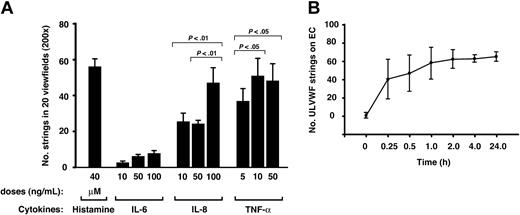
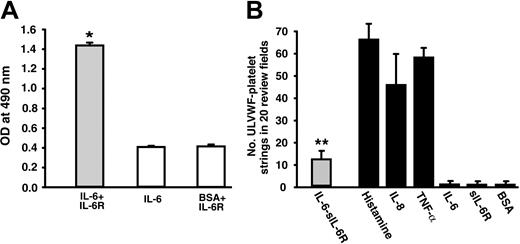
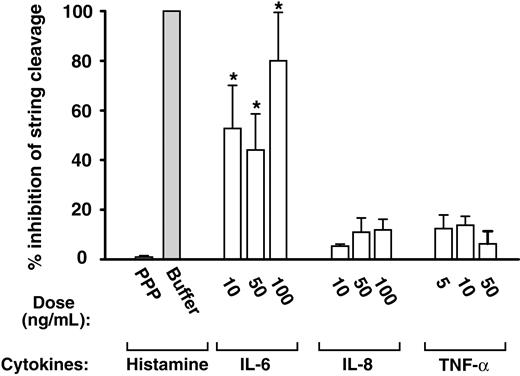
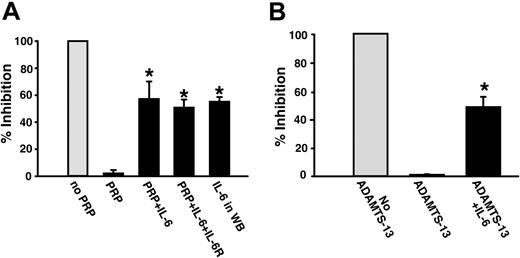
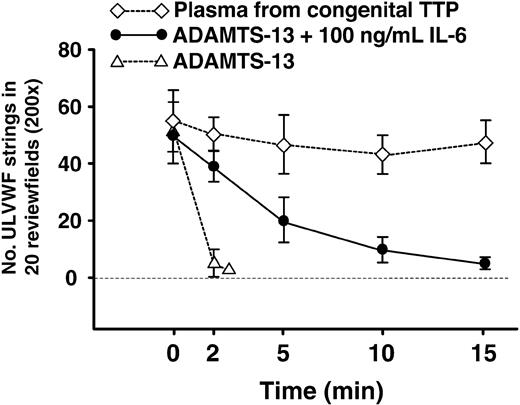
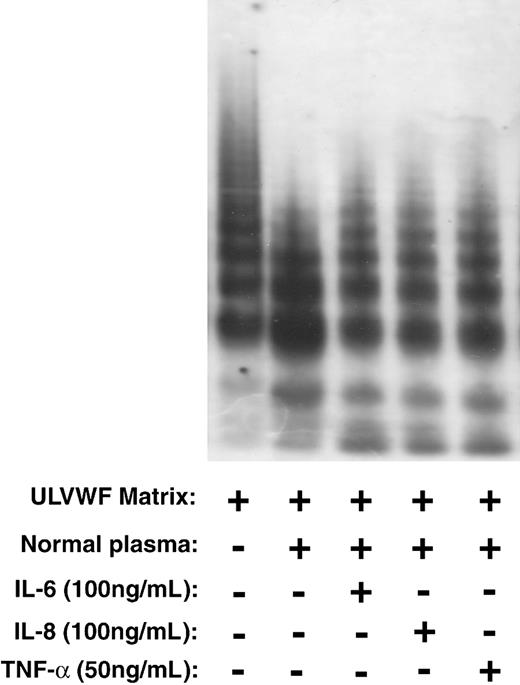
This feature is available to Subscribers Only
Sign In or Create an Account Close Modal